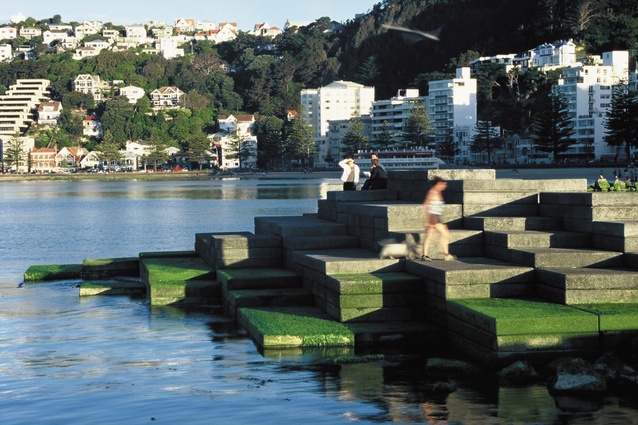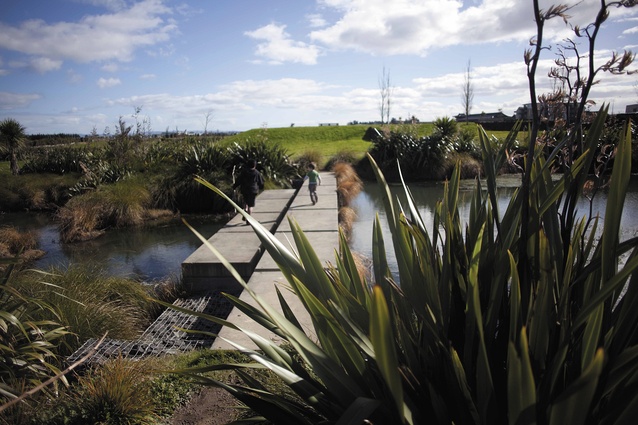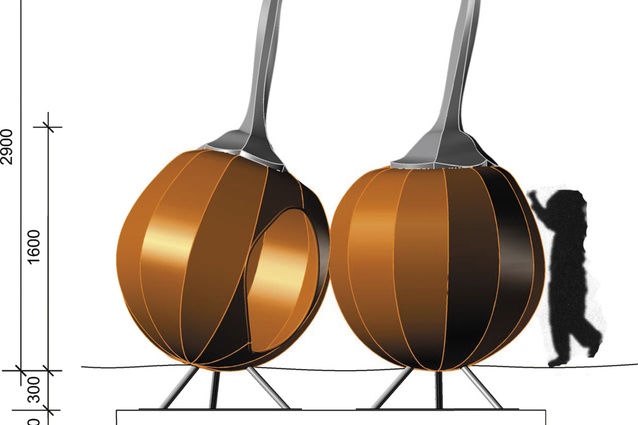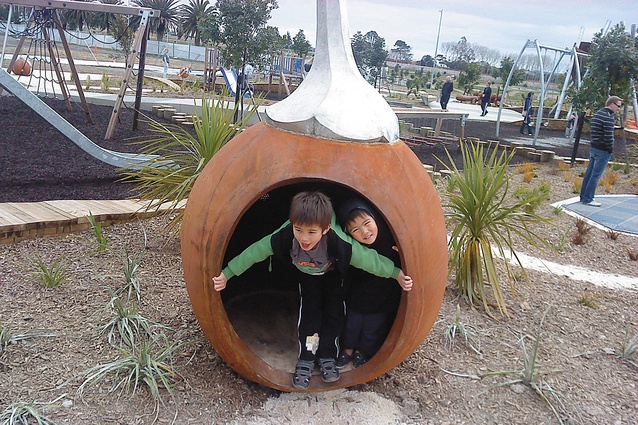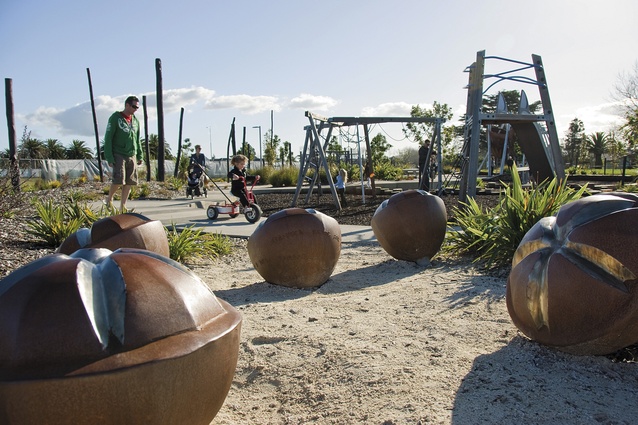Playing naturally
David Irwin shares five thoughts on the evolution of the naturalistic playspaces designed by Isthmus Group.
Over the past couple of months, Isthmus Group’s David Irwin has been on tour, explaining the philosophy behind the award-winning Hobsonville Point park playspace, a Gold Pin winner at last year’s Best Awards. Two other Isthmus playgrounds, at Barry Curtis Park and Wynyard Quarter, mine a similar stylistic vein, and it’s a vein that’s proven successful not just at awards, but with the people who matter. The kids.
The way to play today can be an emotional and personal subject. Irwin says that he’s been influenced by the differences in the way children live now, as opposed to in his youth, and he has concerns that children are losing a connection with the land.
“My daughter is quite comfortable ordering a “hot chocolate, no froth, in a takeaway cup,” he says, “but as a kid, I can remember the smell of freshly cut grass, and making giant bird nests and forts in long grass. I remember exploring the bush, the rocks… Can our children say similar things?”
Perhaps not. A recent New Zealand Herald front page exclaimed that “46% of New Zealand children aged between 8-12 are not playing everyday.” It warns, says Irwin, of a generation of kids who will remember their childhood as one of computer games and sedentary activities rather than afternoons spent playing outside with friends. While some playgrounds, he says, are dull – “…they have all the same stuff and are predictable with little opportunity for creative play” – the bigger issue is, “kids don’t even get there”.
Isthmus’s Hobsonville playground was designed to challenge current playground thinking. “Its about imagination, challenge and unstructured play, nature and ecology,” he says.
Anecdotally, this style of playground is scoring all the right points. The (unscientific, it has to be said) annual New Zealand Herald survey, where a journalist takes her own children out to rank all Auckland’s play grounds, particularly the new ones, has ranked Isthmus projects top for three years running. Irwin is the first to admit, and unconcerned, that some of the themes instilled in these playgrounds might go over the heads of those using them at any given time. At Barry Curtis Park, a wetland-referencing playground, with hides and elevated birds nests, Irwin quizzed a young boy racing about. “Hey, what do you think?” he asked. “The reply was ‘great rocket man!” And that, he says, is “creative play in action”.
Starting point
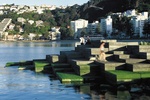
“Oriental Bay – a beach control point, but to us it’s a landscape feature, an abstracted headland, not natural but concrete. Yet you can use it, sit on it, lunch on it. We’ve seen wedding photos on it; seals use it, so do the fish, and there’s seaweed and algae. It has a new ecology. This is the philosophy we take into our playgrounds.”
Into the wetland

“Barry Curtis Park is 100 ha; it includes, wetlands, walkways, cycleways, playing fields, a skatepark and some big spaces. On Waitangi Day 40,000 people were there to celebrate. People learn to ride bikes there, kick balls, ride skateboards, get grazes and have picnics. We work often in the realm of the civil engineer, changing civil structures into active recreation or play opportunities – where we can – and inviting participation in the ‘natural’. We’re constantly dealing with rules and regulations in this environment. The wetland walkway (below) could often be fenced off. Here, if you can find it, you can walk on it. It’s inspired by nature, abstracted and playable. We’ve developed a number of playgrounds based on this philosophy and local landscapes and ecosystems. The playground at Barry Curtis Park has oversized wetland plants, pukekos and bird nests with giant eggs, bird hides to climb into and look over. This is mirrored by a constructed wetland, with real plants and birds, and real bird nests. You have the real thing on one side and an abstracted and fun play experience, with challange and excitement, on the other.”
Giant seeds!
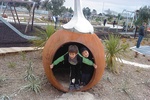
“What happens when a child sees a Kereru or a Tui? Can they tell a Nikau from a Karaka seed? Our key structures are developed with Cicada. We have completed a number of projects together. Once ideas have been developed we workshop on buildability, to further develop the aesthetic. Then we build 3D and real models to further develop the idea. Finally, as it gets built the idea is further refined. It’s a great, but at times scary process. You’re constantly trying to match a strong idea with cost, regulations and the play experience. The seeds speak for themselves – they’re tactile and almost organic.”
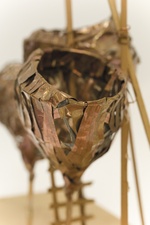
Bird nest
“Here is a bird nest we modelled and built. Ever looked at a bird nest? Really looked at one up close? No wonder our children are drawn to nature – the perfectly simple yet complex structure of a nest; the perfect shape, strength and fragility of an egg. These concepts shape our approach to the design of play environments. Simply, it’s an opportunity to relate to nature and to the ecology of an area. We want to provide a play experience that is inspired by nature, multi-dimensional, creative and educational, to provide an opportunity to reconnect with nature – either through the play structures themselves or through the landscape that surrounds them, as is the case at Hobsonville Point Park.”
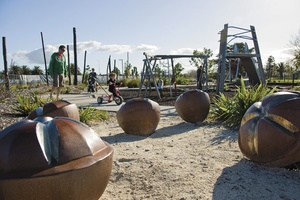
Hobsonville Point Park
“Hobsonville Point is a 195ha residential development we’ve been masterplanning and designing for five years. Hobsonville Point Park forms part of the coastal edge and the coastal edge walkway that links one coast to the other, allowing you to completely circumnavigate the site. It’s an important recreational link for walking, biking, running, scootering, skateboarding and just plain mucking about on the coastal fringe. I hope one day to see kids building huts or a mountainbike jump, or swings from ropes and tyres and sticks hanging in the Poutukawa, which we would never be able to get a consent for, of course. In the centre of this new development is a new park and playground. The park is adjoined by a café in a reused building on the site. There’s a wetland for storm water treatment and an art work by John Reynolds – a work that links the wetland and playground.
The development concept for the park is based on four layers: The underlying landscape with coastal revegetation and the coastal walkaway; The park itself, a clear and simple lineal park design; The playground as the focal point within the park; And the art work by John Reynolds, which forms a line of burnt boundary marker posts that reinforce the lineal nature of the site and connect with the wetland and the playground.
The playground shows off the local coastal-edge ecology. The giant seeds represent the local coastal seed source, nikau, puriri and kowhai, envisaged as dropped by birds. There’s a giant bird nest abstracted from a real fantail nest. Play structures include old-fashioned swings, slides and balance beams. Everything is playable. You can get in the seeds, climb the nest, balance on the seeds, walk edges like tree roots. Everything is detailed for creative play. It’s not obvious like hopscotch – there are no rules – but there are many experiences to be found.”

